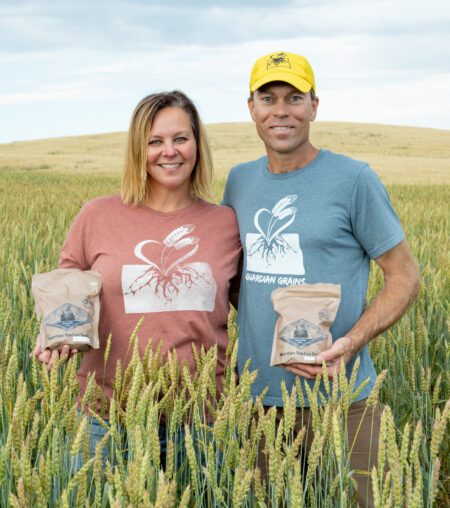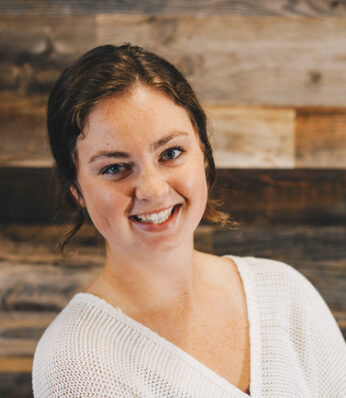Walking on Cloud 9
“We are evaluating our soil now with our senses, it smells like the forest floor, you can hear roots snapping as you dig a spade in, and when you walk on it it feels like you are walking on a cloud.”
Anyone who talks to Kelly and DeAnna Lozensky will be drawn to their magnetic energy and inspired by their unique story. The couple farms 2200 acres in central North Dakota with primarily ancient varieties of oats, wheat, barley, and spelt, and other species such as flax, peas, and mustard. They also manage 600 acres of wildlife habitat and wetlands. In addition to farming, the couple owns and operates Guardian Grains, a direct to consumer food business where they market their whole grains, milled flour and even artisan pasta!
 Going for Yield
Going for Yield
Starting with no-till in 2000, the Lozensky’s have been trying to minimize disturbance as much as possible. Slopes up to 35% grade can lead to serious erosion. That makes keeping the ground covered crucial. At that point, though, they were in a high input system farming over 7000 acres in a 50 mile radius. Kelly expressed, “It’s said that yield pays the bills and they’re right, with all the bills coming in, that is the only thing the yield is paying for”. In that system Kelly and DeAnna were seeing a lot of their income go right back into paying for this high intensity system, where it was common to cover a field 6 times during the growing season with different fertilizer or chemical applications and then of course planting and harvesting on top of that. Inevitably, they were running into compaction problems as the microbial activity in the soil was depleted. On accident they stumbled across the benefits of diverse cover crops and began using a living root to bring their soil back to life.
Silver Lining
In 2014, severe hail damage left a wheat and a pea field completely flattened. The amount of rain from those events prevented spraying the field and by the time Kelly was able to get into the field with a tractor he noticed volunteer wheat and peas. The plants looked pretty healthy so he decided to let them grow and watch what happened. The benefits from the residue of the volunteer crop were evident that fall and even into the following spring. Not only did they eliminate the fall herbicide application, they also captured more moisture in the form of snow and noticed no standing water in the field the following spring. Little did they know this was their first introduction to cover cropping which would eventually lead them to purchase their first cover crop from Green Cover in 2017. Starting with deep rooted plants like radish, safflower, and sunflowers, dealing with compaction was a top concern. With only 134 frost free days and an average 11 inch rainfall (though 2023 only brought 1 inch for the whole growing season) they are farming in one of the world’s most difficult climates yet they are still able to make cover crops and cash crops work together.

From Intensive to Intentional or Profits Up and Labor Down
Once the Lozensky’s began to observe the benefits of cover crops first hand, they decided to plant a diverse pollinator plot. They began by eliminating insecticide entirely which then led to foregoing fungicide as well. Simultaneously, Kelly wanted to try an unpopular fertilizer experiment. They had some ground which had OM levels of 3.5%. He decided to eliminate fertilizer altogether on those 500 acres and see what happened. The results? Because the plants were not receiving excessive synthetic fertilizer, they did not experience any issues with lack of insecticide and fungicide. Also, because they were not overfeeding the cash crops, the weeds were also not getting overfed and they witnessed a reduction in weed pressure as well. “When we invest in soil health, soil health pays, period. It sticks on the farm, it stays on the farm and now soil is our primary asset, we are heavily invested in soil and that makes all the difference” They continued to decrease the amount of fertilizer by 20% every year for five years. Around this time the couple also decided to weed out landlords that were not on the same page regarding soil health. This dropped their total farmed acres by over 50% and now they currently own 80% of the ground they farm. In their words “Profitability has increased, labor has decreased”. Then, of course, came the next obvious question, what to do with that extra time and capital!
Lotsa Pasta! Or Did Somebody say bread?
With this newfound time and a little extra cash in their pocket, Kelly and DeAnna decided to begin direct marketing some of their own products they grow on the farm. DeAnna dreamed of connecting her farm’s story to other people’s lives. “I really wanted to bring the grains we were growing to people’s plate.” To do this, they started putting their products on their own plates and in fact, have not purchased store bought bread in 3 years. She adds, “If more farmers put the food they are growing on their plates first it will change the way they grow the crops.” With a low input system and limited chemical applications, the Lozensky’s are confident with the quality and healthfulness of their grains to provide nutritious bread, pasta and much more for their family. This builds trust with consumers and connects the story of the soil to the end consumer. They also utilize ancient varieties of wheat, spelt, and barley due to the added soil health benefits. The elimination of insecticide and fungicide in concert with utilizing cover crops made the underground biology explode! All this biology of course needs to eat. As the biology ramped up they found it more and more difficult to keep the ground covered with residue, as the microbes were consuming everything quite quickly. Now the Lozensky’s focus on high carbon cover and cash crops to maintain adequate protection on their topographically steep farm. Ancient grains provide more above ground biomass and a more robust root system to help feed this hungry and thriving ecosystem they manage. While this endeavor has provided a creative outlet and unique small business opportunity, they do stress that this is NOT a critical element to their profitability. “You don’t have to do the direct marketing to be profitable, the vast majority of our grain still goes to the elevator.” Every farmer should choose what they do with their newfound freedom after being released from the bond of chasing a yield.
Closing Thoughts
At the end of the day “Soil health pays, always!” The Lozensky couple has seen this proven over and over on their farm. They also stress that “water matters” especially when you are dealing with extreme drought, and “something growing is better than nothing”. Additionally, “A resilient system takes TIME to build, and faith, and grace…You have to catch a break at some point or nobody would be doing it.”
This article first appeared in the 10th Edition of Green Cover's Soil Health Resource Guide.
Also check out the 11th edition, our latest Soil Health Resource Guide, over 90 pages packed with scientific articles and fascinating stories from soil health experts, researchers, farmers, innovators, and more! All as our complimentary gift to you, a fellow soil health enthusiast!
 Going for Yield
Going for Yield